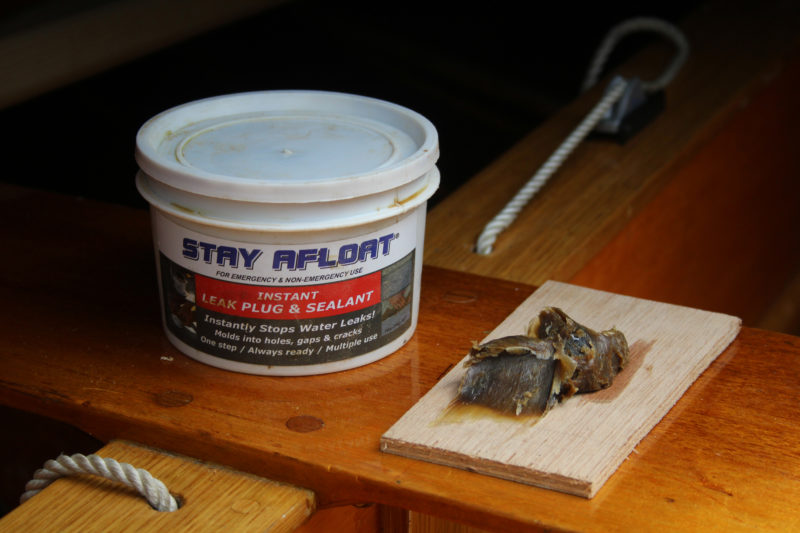 Photographs and video by the author
Photographs and video by the authorStay-Afloat is a soft, sticky, wax-like material made of treated petroleum byproducts.
"A leaky boat never sinks,” or at least that is what my father led me to believe when he kept a 27′ carvel-planked sloop at my hometown’s marina. If you know a boat’s likely to take on a bit of water, you’re going to keep an eye on it and be prepared to do something about the leaks. If you’ve been lulled into complacency by a boat that doesn’t leak, a little unexpected trickle of water could lead to a sinking. A small boat kept on a trailer isn’t going to sink while it’s idle, but leaks can occur when it’s in use, so it’s a good idea to be prepared to fix them.
Stay Afloat is soft, sticky wax-like material meant to fix small leaks of the sort I get with my older lapstrake boats. None of my boats had suffered enough damage to let water aboard, but that’s a possibility worth preparing for.
To test the effectiveness of Stay Afloat I wasn’t about to poke holes in any of my boats, so I made a gizmo that could simulate leaks. It’s a plywood box with a piece of 7″ plastic drainpipe connected to it. The FAQs on the Stay Afloat website say: “Stay Afloat has been tested…at 3 meters deep for 24 hours with no compromise. It also depends on how much material you use and how big the damage area is. Common sense: the bigger the hole the more you use.”

My leak-testing device created pressure equivalent to that of 26″-deep water.
Stay Afloat’s documented testing depth of about 9′ provided much more underwater pressure than a small boat’s leak would be subject to. The pipe I had on hand, 26″ in length, would create less pressure than their test, but more than the draft of any of my boats would. The 26″ water column might represent a worst-case scenario of rough water. I kept the hose running during my tests to keep the water level from dropping when the test leaks were opened up.
I got my first test of Stay Afloat as soon as I filled the pipe with water. I had caulked the plywood box seams and the pipe-to-plywood joint, but there were several leaks. I smeared Stay Afloat wherever there was a leak and soon had my device watertight.
Cracks, mimicked by saw kerfs from 1/32″ to 1/8″, were easy to seal even with the full pressure. A thin crack was fixed with a swipe or two, wider ones needed a bit more. A 3/4″-diameter hole held the Stay-Afloat fix, even when applied with a geyser of water issuing up from the hole and with the full pressure from the 26″ water column. A 1-1/2″ hole was another matter. The Stay Afloat wasn’t stiff enough to keep from bulging up after being applied, and ultimately tore away from the sides of the hole. Putting a patch of cloth over the Stay Afloat didn’t help, but a flat piece of wood or metal did. The rigid patch provided more surface area to create an adhesive bond strong enough to hold the plug in place.
Soap, water, and a rag are recommended for cleaning your hands after using Stay Afloat. It is very gooey stuff, and a rag is necessary to rub it off. Stay Afloat is incompatible with adhesives, paint, and varnish, so a permanent fix for a leak stopped with it starts with the complete removal of the stuff from the damaged area. The website’s FAQs recommend that surfaces be scraped clean, then wiped down with an acetone-soaked rag.
After scraping a test piece to remove an application of Stay Afloat, it still repelled water, as I expected. With a single wipe-down with acetone, water still beaded up, but after three wipe-downs the water soaked into the wood grain, a sign that the wood was ready for permanent repair. That test was with a flat, easily accessible surface; properly repairing cracks and fractured plywood would likely require the removal of wax-contaminated wood. For leaks that occur while a traditionally planked boat is swelling up after a long period of dry storage, the Stay Afloat stays quite malleable and will squeeze out as the seams close.

This wax toilet ring has a color similar to beeswax, but as with Stay-Afloat, the material commonly used is a blend of petroleum byproducts.
When I was researching Stay Afloat, I saw it was being compared to the soft wax ring used to seal the connection between the bottom of a toilet and the drain in the bathroom floor. I had recently remodeled a bathroom in my home and so had a spare ring. The waxy material is like Stay Afloat in nearly every aspect except color, and performed as well. The wax, separated from the plastic fitting that it surrounds, weighed a bit over 5 oz, so a $7 ring comes out to be a bit cheaper than Stay Afloat (the math comes to $19 for 14 oz—about $6 less than Stay Afloat for the same amount). However, you’d want to carry three rings worth because a single ring wouldn’t cover a series of leaks, then you’d need a container for them and have the very messy task of freeing the “wax” from the plastic rings.
Stay Afloat is a good way to seal leaks from the inside of a small-boat hull whether they’re chronic or sudden. Having a jar of it handy, along with a few patches of plywood, would prepare you for putting a quick stop to water getting through the hull.![]()
Christopher Cunningham is the editor of Small Boats Monthly.
Stay Afloat is $24.99 per 14-oz jar and available from select retailers.
Is there a product that might be useful for boatbuilding, cruising or shore-side camping that you’d like us to review? Please email your suggestions.












Used a similar product last winter to help keep my dory afloat called Slick Seam, fighting a leaking check. Worked pretty well, but I had to be careful not to scrape it off when I was deicing the boat with a plastic dustpan. (A few pounds of rock salt helped keep the ice mushy.) I backed it up with British plumber’s tape called Denzo. Check now has a spline. When you want paint to stick after using one of these waxy products, scraping followed with a solvent will be needed.